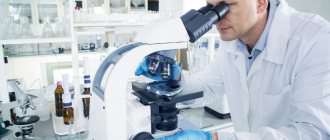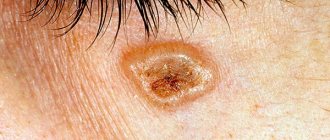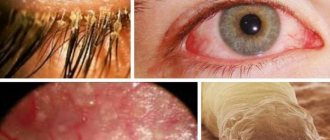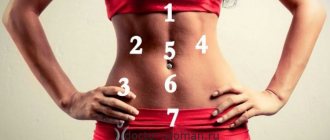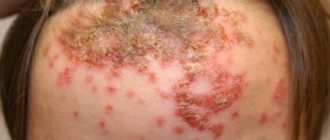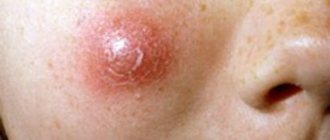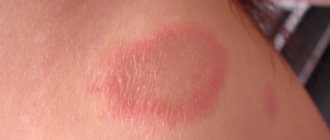Urticaria pigmentosa. Causes of the disease
The clear reasons are unknown. The disease has not been sufficiently studied.
Sometimes it is formed without visible prerequisites. Under some circumstances, doctors believe that the disease is inherited - as an autosomal dominant gene trait. However, not all people with the problematic gene suffer from this disorder.
Usually it is caused by a gene combination of specific characteristics located on chromosomes. The defective gene can be inherited from two parents or from just one. The risk of transmission is about 50%.
In many cases, the disease appears due to an inadequate concentration of inflammatory cells in the skin, exceeding the norm. The cells are called mast cells.
Factors contributing to an increase in the number of mast cells:
- physical irritants (such as heat or strong friction);
- excessive physical activity;
- bacteria;
- poisoning;
- dextran in eye drops;
- alcohol;
- certain foods (crustaceans, fish, cheese, spicy foods, excessively hot drinks);
- frequent use of painkillers;
- stress and depression.
Sometimes the described pathology is preceded by mastocytosis. However, the opposite situation is more common, when mastocyosis is a complication after it.
As people age, the likelihood of mastocytosis increases in those who suffer from the disease.
Types of urticaria
The type of urticaria depends on the mechanism of triggering the disease.
- Allergic urticaria. Caused by ingestion of antibiotics and anti-inflammatory drugs. Commonly prescribed drugs include tetracycline, amoxicillin, flemoxin, aspirin, ibuprofen, and nise. Alcohol consumption can accelerate and intensify the course of the disease. Antibiotics accumulate in the body, so the problem does not manifest itself immediately. The course can be completed, and hives will appear in a couple of weeks.
- Food urticaria. It occurs more often in children after eating certain foods - fruits (citrus fruits and strawberries), fermented milk, fish products, nuts and sweets. This type of urticaria is not dangerous, goes away quickly, and occurs due to the body producing antibodies to a new product.
- Contact urticaria. Side effect during professional activities (reaction to latex in surgeons, allergies to chemicals in cleaners).
- Reaction to the sting of a wasp, horsefly, hornet. The most dangerous manifestation of allergies is angioedema, when the bitten person dies an hour after the bite.
- Reaction to the presence of a virus in the body. Sometimes the rash is provoked by intoxication due to fungal infections (staphylococcus, candidiasis (thrush), tonsillitis, pharyngitis). If the disease is cured, the redness on the skin will disappear.
- Nervous urticaria.
In a state of stress, the functioning of the parasympathetic and sympathetic nervous systems diverges, the signaling system fails, and our body incorrectly interprets the impulses sent by the brain. The stress hormone adrenaline is released, blood vessels dilate, their walls stretch and become permeable. Endothelial cells lining the vascular and capillary walls swell, forming red bumps on the surface. This condition is also urticaria.
According to the intensity of its occurrence, urticaria can be:
- Spicy. Caused by allergenic foods, medications, chemicals, insect bites. Lasts up to 6 weeks, after which it disappears completely.
- Chronic. Lasts over 6 weeks, after which in 60% the symptoms disappear. In 40% they remain and are observed throughout life.
Atypical forms of urticaria include the following types:
- Cholinergic. It occurs due to weakened immunity and an increase in the amount of acetylcholine, a neurotransmitter involved in the transmission of nerve impulses.
- Adrenergic. It is caused by a sharp release of the hormone adrenaline into the blood. The reason for this is severe stress or mental agitation. The rash, which looks like pale pink blisters, often occurs in people who have to do things they don't like.
- Contact. Occurs due to direct contact with an allergen (pets, metal jewelry). Disappears immediately after contact with the source of the allergic reaction is broken.
- Aquagenic. It can be observed when the patient comes into contact with water. Water is not an allergen, but an activator of allergies to a certain substance. It often occurs during trips abroad, when the local climate promotes the production of histamines (transmitters), and water accelerates its production.
- Quincke's edema. The most acute manifestation of urticaria is Quincke's edema - angioedema with deep skin lesions.
With Quincke's edema, not only the surface of the skin is affected, but also the mucous membranes of internal organs, in particular the lungs, esophagus, and stomach. Antibodies produced by the body affect nerve endings and blood vessels, increasing their permeability and expanding the lumen. Plasma penetrates through the vascular walls to the outside, paralyzed nerve cells reduce vascular tone, provoking the accumulation of membrane fluid in tissue cells. Severe swelling can occur in both the brain and lungs, leading to almost instant death.
Urticaria pigmentosa. Symptoms and manifestations
Pathology can develop in people of all age categories. However, symptoms are dictated by age. About half suffer solely from changes to the surface of the skin.
In general, dermatologists distinguish two key types of pathology:
- Children's cutaneous mastociosis. Progresses in the first 24 months after birth. The rashes appear exclusively externally and do not affect the insides of the body. Before pubertal hormonal changes, all symptoms usually disappear without a trace and never reappear.
- Adolescent and adult mastociosis. Formed in adolescents from 12 years of age and adults. Not only the outer skin surface suffers, but also the insides. Sometimes the pathology develops into a systemic mastoid form.
READ ALSO: Chickenpox in adults and how it begins: symptoms and treatment
Pathology also has two types of external manifestations:
- single tumor (a single formation on the epidermis that appears in the mastocytoma form);
- profuse rashes over the entire surface of the body (in a generalized form).
The latter type is more common.
Hives: what is it?
According to statistics based on dermatological practice, urticaria occurs at least once in a lifetime in 20% of the population. In 30% of all cases, the disease becomes chronic, often caused by the lack of timely treatment.
Development mechanisms
The basis of the pathogenesis of urticaria is the release (degranulation) of histamine from mast cells of the skin, where it is synthesized and accumulated.
It is a mediator of allergic reactions and a participant in inflammatory processes. On the face, mast cells are located in the connective tissue of the skin. On their surface there are receptors for immune system antibodies produced when the body comes into contact with a foreign compound (allergen).
After antibodies bind to receptors, the structure of the mast cell membrane changes, and the histamine contained in them is forced out of the granules through the pores.
Histamine entering the surrounding tissue increases the permeability of the vascular walls and causes muscle spasm.
At the site of action of histamine, a local rush of blood occurs, which increases the osmotic pressure in the vessels. Blood plasma sweats through the walls of blood vessels into the interstitial space. A red rash with blisters (urticarial rash) appears on the surface of the skin, and as a result of irritation of nerve receptors, itching occurs.
The pathological process can occur without the participation of the immune system. This reaction of the body is called pseudo-allergic. This occurs in cases of congenital or acquired deficiency of mast cell membranes, their inadequate response to the effects of humoral and physical agents.
Causes of urticaria
People with congenital or acquired hypersensitivity of the body are at risk of developing urticaria. Triggers of the disease can be external and internal factors.
Allergic form
The most common form of dermatitis with an immunological mechanism of development.
- food products obligate allergens;
- medications: penicillins, sulfonamides, muscle relaxants, barbiturants, aspirin-containing drugs, B vitamins;
- wool, feathers, saliva, animal excrement;
- insect bites, particles of their bodies and waste products entering the body;
- active substances of detergents and hygiene products, animal feed, dust, household insects;
- pollen of flowering plants;
- toxins, metabolite products and decay of viruses, fungi and bacteria in infectious pathologies.
Allergic urticaria is characteristic of the acute form of the disease and is extremely rarely observed in the chronic form. In the chronic form of the disease, the triggers that provoke relapses are mainly internal diseases of the body and autopathological processes.
Physical urticaria
In this case, physical factors become the cause of exacerbation of urticaria. This type of urticaria is relatively rare, accounting for up to 20% of all cases.
- mechanical irritation or compression of the skin;
- external or internal exposure to cold (contact with snow, cold drinks);
- insolation, x-rays;
- vibration;
- overheating of the body;
- aquagenic factors: the body’s reaction to substances dissolved in water.
Endogenous
This group combines types of dermatitis that appear due to internal pathologies or disorders of the body.
Urticaria is one of the symptoms of the disease:
- sarcoidosis, amyloidosis;
- diabetes mellitus (usually hidden);
- rheumatoid arthritis;
- blood diseases;
- Gastrointestinal tract (chronic gastritis and ulcers, gastroesophageal reflux disease);
- endocrine system (imbalance of cortisol and histamine);
- inflammation in the gallbladder;
- parasitic infestations;
- autoimmune pathologies (collagenosis);
- Schindler's syndrome;
- some tumors.
In cases where it is not possible to determine the cause of the disease, a diagnosis of idiopathic urticaria is made. This occurs in 80% of cases of chronic urticaria.
The mediators of the body's pseudo-allergic reaction are pharmacological drugs: non-steroidal anti-inflammatory drugs, ACE inhibitors, antibiotics (polymyxins), morphine derivatives. The cause may be foods high in histamine, insect poisons, alcohol and natural salicylates.
Symptoms of urticaria on the face
Depending on the duration of the course, urticaria can be acute or chronic.
The acute form of the disease begins suddenly and can last from several days to 6 weeks. When the disease progresses for more than 6 weeks, chronic urticaria is diagnosed. This form of the disease can last for decades with exacerbations and periods of remission. In 50% of cases the disease stops spontaneously.
Despite the polyetiology, the manifestations of urticaria are uniform, the only difference between the forms of the disease is the intensity of the symptoms.
First of all, there is an increasing itching in the lesions and filling of the vessels with blood. A red rash appears on the face, protruding above the surface of the skin. Gradually, the papillary layer of the dermis swells, exudate is released, and blisters form.
The size of the blisters is from 2 mm to 3 cm. A distinctive feature is a red border along the periphery and a pale center, round or irregular in shape. This is a temporary phenomenon; after the destruction of histamine, on average within a day, the blisters are eliminated without a trace.
On the face and other parts of the head and neck, mast cells are more densely distributed relative to other parts of the body. Therefore, the rashes in these areas are characterized by intensity, severe itching and burning.
With chronic urticaria or the absence of treatment for the acute form, the urticarial rash can transform into papular rash. This is the formation of dense red papules. A characteristic feature of these cases is more intense itching, intensifying at night.
Urticaria pigmentosa in children
Urticaria pigmentosa in children is formed by pinkish-red marks on the epidermis (can be seen in the photo) and severe itching. As the spots develop, they turn into blisters filled with liquid. Externally, it is transparent or pinkish (due to the blood content),
The blisters are accompanied by swelling, and when irritated they react with new damage. The bubble formation swells even more intensely, turns red and itches. A similar reaction occurs when compressed and exposed to temperature.
For example, while taking a bath or being exposed to sun radiation. In some circumstances, the reaction takes place without leaving any traces. However, more often it leaves behind brown-brown pigment spots.
Occasionally, not blisters are visible on the epidermis, but nodules of a reddish tint. In this case, there is no response to new damage.
As a rule, the rash appears only on the torso. But it can spread to the face and hands. The matter does not go further than this. Rarely do rashes cover the entire skin surface.
Some other manifestations:
- Thickening of the skin. And the formation of more obvious folds.
- Yellowness. The skin gradually acquires a yellowish tint. Partly due to coarsening.
- Tumor-like nodule. Formed in the cervical and forearm areas or on the torso. In diameter - up to 40-50 mm. Usually there is only one nodule. Less often there are four, but this is the maximum. Feels like rubber. The surface is smooth or with folds. When damaged, it forms blisters or pustules. Examples can be seen in the photo of urticaria pigmentosa.
After opening, some bubbles become covered with cracks and form ulcers.
Usually the pathology occurs without malignancy and does not cause complications. At puberty, symptoms go away on their own.
READ ALSO: Top 10 strips for blackheads on the face and nose: black and other options to choose from with price and reviews
What is urticaria pigmentosa, its symptoms and how to treat it
Urticaria pigmentosa is one of the most common forms of a rare disease called mastocytosis. In many cases, children are susceptible to this disease, but adult women and men can also get it.
Mastocytosis is a disease in which mast cells multiply and accumulate in living tissues. Mast cells are a fairly significant part of the human immune system, so many experts are confident that urticaria pigmentosa appears when the body’s immunity is impaired.
Children most often suffer from urticaria pigmentosa; spots appear on their body, red or pink, and later they change into subcutaneous blisters, inside of which there is water. After they heal, traces of a brownish tint remain on the body. Sometimes they disappear, and sometimes they remain and may even increase in size.
In adults, urticaria pigmentosa begins to occur in the form of spots that have a clear border and are absolutely smooth; nodular formations no larger than 5 mm may occur, and there may be rashes in the form of blisters. These inflammations can be seasonal or appear from any damage to the skin, sometimes they are with a person throughout his life, then disappearing, then appearing again.
Symptoms of the disease
The symptoms that characterize this disease directly depend on where exactly, in which layers of the epidermis, substances released from mast cells have accumulated.
Doctors are used to dividing the skin reactions that occur with urticaria pigmentosa into five types:
- Maculopapular. Many small nodules or dark spots form on the skin. Localization is clearly limited. If you apply mechanical force to them, small bubbles may appear.
- Nodal. With this type, many convex seals or nodules appear on a person’s skin. The color of the formations that appear is usually red, pink or yellow. Sometimes the nodules, due to their close proximity to each other, merge into plaques.
- Solitary. A knot no larger than 50 mm in size is formed; when you touch it, you might think that it is rubber. These nodes are called mastocytomas. Their localization is usually on the arms or neck, on the torso. Usually only one nodule appears, but it is possible to increase their number to four. They have the ability to disappear on their own.
- Telangiectatic. This type usually affects women in adulthood. They have red-brown spots on their body, mainly on their chest.
- Erythrodermic. Yellowish-brown areas appear on the human skin, quite dense, they have uneven edges, but the border is clearly visible. With this form of the disease, a person suffers from severe itching, which, as a result of scratching the affected areas of the body, leads to small ulcers and cracks.
With minor exposure, blisters may appear and the itching may become worse.
There is a risk of developing a bullous form, when there are a lot of bubbles. The transformation into a systemic form occurs much less frequently, but then the entire skin will be affected, will peel off and be very difficult to treat. In addition to the signs that appear with urticaria pigmentosa on the skin, the following symptoms may appear:
- the human body temperature rises;
- blood pressure decreases for unknown reasons;
- severe itching and redness of the skin;
- attacks of tachycardia.
These symptoms may indicate that the disease may have damaged a person's internal organs. And in this case, it already becomes quite life-threatening and requires good and professional treatment.
There are several forms of mastocytosis:
- systemic. It usually appears in adults and affects the tissues of the internal organs of a person, but there may or may not be skin lesions;
- cutaneous This form includes both infantile and adult mastocytosis. With this form, in infancy and adolescence, only the skin is affected; the disease does not spread to the tissues of internal organs. Cases of transition to the adult form are very rare;
- malignant. It degenerates mast cells into a malignant form. There may not be inflammation on the skin; it only affects the internal organs. Difficult to treat and can lead to death.
- adult or teenage form. It manifests itself as symptoms on the skin, but also affects the internal organs of a person, the heart, kidneys, and stomach. Although such lesions rarely progress and become systemic.
Treatment of urticaria pigmentosa
For this disease, treatment must be prescribed by a doctor; it is individual and depends on many factors:
- symptoms;
- age of the sick person;
- causes of the disease.
When mastocytosis affects children, but there are no strong symptoms on the skin, then no therapy is prescribed, since everything goes away on its own before adolescence.
When cases are more complex, drug treatment is prescribed. Antihistamines such as:
- Cetirizine;
- Suprastin;
- Tavegil;
- Diazolin et al.
Anti-bradykinin drugs such as:
Antiserotonin drugs such as:
- Ketotifen;
- Bicarfen;
- Periactin et al.
Corticosteroid drugs, drugs based on cromoglyceric acid, such as:
- Intal;
- Nalkrom;
- KromHexal et al.
Drugs from the group of cytostatics:
PUVA therapy may also be prescribed. This method involves exposing the skin to photoactive substances, medications and ultraviolet rays. If the symptoms on the skin are very pronounced, they can be removed through surgery.
The treatment prescribed by the doctor will always depend on the form of the disease. And in each case, the approach will be different. Therefore, at the first signs of this disease, you should immediately consult a doctor. He will conduct the necessary tests and studies, and, having determined the form of mastocytosis, will be able to make an accurate diagnosis and prescribe appropriate treatment.
You should always follow the treatment regimen prescribed by the doctor; you should not prescribe or use drugs on your own that the specialist did not mention.
If there is a definite need to find out about the drug that you want to use, then it is better to first ask your doctor about it, in case it is not suitable for you at all.
And you will not only spend extra money, but you can also worsen your situation.
Elena Malysheva. Symptoms and treatment of urticaria
Treatment of urticaria pigmentosa, in addition to medication and physiotherapy, also includes adherence to a special diet. With such a diet, all salty, fatty, smoked and spicy foods are prohibited.
It is advisable to steam foods or eat them boiled. It is imperative to exclude soda and drinks containing alcohol from drinks. Fans of spicy seasonings and sauces will also have to give them up.
You can also resort to old traditional methods of treatment, but you must first consult with your doctor. For example:
- Nettle infusion. Add a spoonful of nettle leaves to a glass of boiling water and let it brew for no more than thirty minutes. And then drink 4 or 5 times a day, half a glass of warm infusion.
- Celery juice. This method is not suitable for everyone, since celery has a rather specific taste, but if you don’t mind trying it, you should drink the juice three times a day, half a glass before meals.
- Beetroot infusion. Fresh beets, peel, cut into small pieces and add three liters of water. Keep this in a dark place for no more than six days. Next you need to drink one tbsp. l. three times a day. You can also apply compresses to the affected areas of the body.
- Potato compress. This type of home treatment is quite common and helps with many skin inflammations, soothes it, and relieves itching. You need to take fresh potatoes, grate them and, wrap them in gauze, apply the resulting compress to the inflamed and affected areas of the skin for no more than forty minutes.
- Baths with herbal infusions. You can also take medicated baths to soothe your skin. To do this, you need to mix celandine, chamomile, valerian, sage and string in equal parts, pour everything with plain water and boil for about 10 minutes. Next, it is infused for about half an hour, and then the resulting infusion must be added to a bath filled with warm water. It is not recommended to take such a bath for more than 10 minutes.
Hives. Types and signs of urticaria, causes and treatment
People who have been diagnosed with any form of mastocytosis should take preventative measures such as:
- Increase your immunity by taking vitamins or undergoing special therapy;
- Follow the diet prescribed by your doctor;
- Eliminate or replace certain medications that must be notified to your physician.
- Be sure to treat inflamed areas of skin with caution, do not injure them or apply mechanical stress.
Sometimes, in adults, urticaria pigmentosa sometimes disappears and then appears again; they need to very carefully monitor the symptoms of the disease, and at the first signs of its relapse, go to the doctor.
Disease prognosis
The prognosis for such a disease will directly depend on its form. If a small child gets sick, then in almost all cases, the disease will go away on its own before puberty. In rare cases, it develops into an adult form.
If a teenager gets urticaria pigmentosa, the chance of completely recovering from it is about 50%. When urticaria pigmentosa affects an adult, it usually does not end with inflammation of the skin; internal organs are also affected. If the disease develops into a systemic form of mastocytosis, it can be fatal.
If urticaria pigmentosa affects only the skin of a person, then a dermatologist will treat him. And if the disease affects internal organs, then specialists in other fields will monitor the patient and treat him, for example, an oncologist or hematologist.
As you can understand from this article, this disease has various forms and can flow from one to another. In childhood, it is much easier to tolerate, therefore, if the disease has overtaken an adult, you need to carefully monitor the course of the disease and do not forget to visit your doctor.
Source: https://allergolog.guru/zabolevaniya/pigmentnaya-krapivnica.html
Urticaria pigmentosa in adults
Urticaria pigmentosa in adults manifests itself in the form of streamlined spots. Diameter - no more than 5 mm.
The edges of the formations are clearly defined and have a smooth surface. Color - dull gray or brownish-pinkish. As a rule, they appear on the body, without initially affecting the face.
Migration to the face and limbs occurs over time - with the evolution of the disease. Then the formations take on the shape of a sphere and change color to a darker color - brown, pinkish-red or dirty brown. The distribution process can occur intermittently and drag on for years.
For urticaria pigmentosa in adults, treatment is predominantly medicinal.
With age, the pathology progresses. A complication arises - mastocytosis of a systemic type, that is, it affects the insides of a person. This leads to death because the functionality of the organs is impaired.
Food causes of skin rashes
Frequent causes of acute urticaria in children and adults are a consequence of an inadequate response of the immune system to provoking factors. There are many such factors in the environment: people live in a world of bacteria and microorganisms, viruses and allergens. Acute allergic urticaria can occur as a response to food allergens, medications, synthetic substances and fabrics, hot or too cold weather: for example, cold urticaria.
“Thermal urticaria” can “merge” into one large spot
Acute urticaria, as a rule, can occur in response to the consumption of certain foods. Experts have long identified a number of foods, the consumption of which causes acute allergic urticaria in children and adults. Products that provoke an allergic response include:
- citrus;
- chocolate and chocolate products;
- red berries, such as strawberries or raspberries;
- smoked sausage, fish, meat;
- tomatoes and tomato juice;
- bee products, including honey;
- some types of nuts.
It is not difficult to determine the allergen if a person who has discovered symptoms of acute urticaria looks for the reasons in his diet. If such products are not available, the reasons should be looked at in other provoking factors in the surrounding world.
Note. Doctors also classify yeast as an allergen, so both an adult and a small child can begin to itch even after eating a regular sweet cheesecake.
We recommend studying this topic:
Features of idiopathic urticaria and principles of treatment of autoimmune disease
3572
0
7
reading information
Itching is considered a common accompaniment of “urticaria”
Often, the appearance of symptoms of acute urticaria in children is caused by certain foods, and a special diagnostic test for allergy tests will help to find the provoking allergen.
Urticaria pigmentosa. Treatment
First, some precautions:
- Do not injure your skin. Try not to rub or comb it. Under no circumstances should you puncture the bubbles or squeeze out the contents.
- Limit skin contact with environmental factors. Reduce the amount of clothing, wear looser clothes. Spend less time in the sun. Avoid hot baths, they will only harm you.
- Don't take aspirin. And codeine.
Understanding the causes of the disease and avoiding its symptoms can become a residual measure in a mild form of the pathology.
Diagnostics
The appearance of hives on the face is a reason to consult a dermatologist or allergist.
The basis for successful treatment of a disease is eliminating the cause, which can only be determined after a detailed examination of the body. Diagnosis of pathology begins with a physical examination and medical history. The doctor evaluates the nature, frequency and duration of rashes, the time of appearance and disappearance of blisters. At the same time, the presence of current pathologies, allergic dermatoses in the hereditary line, features of lifestyle and diet are clarified.
Mandatory laboratory tests:
- clinical and biochemical blood tests;
- general urine analysis;
- testing for hepatitis B, C and RW;
- allergy examinations (skin tests).
Studies for selected indications:
- rheumatic tests;
- coproocystoscopy;
- bacteriological studies (stool, material from mucous membranes);
- identification of infectious agents;
- tests for the presence of parasites.
- Ultrasound of internal organs;
- ECG;
- EGDS;
- X-ray of the chest cavity and nasopharynx.
If physical urticaria is suspected, the method of provocative tests is used:
- mechanical irritation of the skin;
- exposure to cold;
- water compresses;
- physical activity, immersion in a hot bath;
- photoirradiation.
Further examination of the patient is carried out based on the results of the initial diagnosis. In this case, provocative tests are used for different types of allergens, screening studies for hormone levels, differentiation is carried out from other types of dermatitis with a possible urticarial rash.
Drug treatment of urticaria pigmentosa includes:
- Antihistamines type H1. Reduce symptoms such as itching and hyperemia.
- Antihistamines type H2. Reduce acidity levels.
- H1 and H2 blockers. Reduce the likelihood of anaphylactic shock. In serious cases, the patient is given a special medical bracelet, which lets them know about the release of histamines. Then the patient needs to inject himself with adrenaline.
- Mast cell stabilizers. Needed for abdominal pain, diarrhea, bone pain and headaches. Drink for a week.
- Products containing aspirin. Prescribed carefully and in small dosages. Needed for those suffering from vascular insufficiency.
- Photochemotherapy. UVA rays. Reduces total mast cell volume. Therapy is carried out in sessions - 2-3 sessions per week. Reduces the degree of itching and externally transforms the skin surface.
- Steroid drugs. Internal or in cream format. Used for general mastocytosis.
READ ALSO: Rashes on the head: TOP treatment methods
Sometimes treatment is not enough for urticaria pigmentosa. Some resort to cosmetic measures and remove dark pigmentation.
Treatment of urticaria pigmentosa with folk remedies
Therapy can be supplemented with traditional home remedies. Several recipes:
- Aloe juice. Squeeze a little mixture onto a sterile bandage. Apply a compress to the affected areas. You cannot massage the areas or rub juice into them. This will make matters worse. A course of aloe compresses is 8-10 minutes once a day.
- Ginger. Pour boiling water over the root parts (5-7 pieces per 0.5 liters of boiling water). Let cool. Soak gauze in the mixture and apply a compress to the affected areas. No more than 10 minutes a day.
- Green tea. Drink 200 ml of this tea daily. Before lunch. It is a natural antioxidant that will help promote the release of toxic elements and reduce the degree of skin inflammation.
- Milk of magnesia. Soak a cotton pad in milk and apply it to the affected area for 5-7 minutes.
- Avoid alcohol.
- Avoid spicy foods and fried foods.
- Add unrefined olive and coconut oils to your diet.
- Increase the amount of water you consume.
- Avoid saturated animal fats (milk).
- Consume more omega-3s.
- Eat plenty of fiber (whole grain baked goods).
- Reduce the level of sweet and salty foods in your diet.
- Give preference to vegetables.
Physical activity may also improve the condition.
Urticaria treatment complex
Urticaria is a complex dermatosis that requires an integrated approach to therapy. This is the elimination (elimination) of the allergen, treatment of symptomatic manifestations and internal diseases, restoration and strengthening of the body. Despite the variety of causes and forms, the basic principles of treating the disease are the same.
Elimination measures
After diagnosing urticaria, elimination measures are carried out, which consist in excluding provoking factors. This is an effective form of therapy and prevention, especially if the factors are identified.
For allergic urticaria, the patient is prescribed table No. 5. This is a hypoallergenic diet that excludes all potential allergens. Other causative allergens should also be eliminated. In acute urticaria, eliminating the allergen leads to resolution of symptoms within 24-48 hours.
Patients with physical urticaria should be protected from physical stimuli that cause this type of illness.
In the chronic form of the disease, pseudo-allergic reactions are more often observed, and on the contrary, the allergen almost never causes an exacerbation. Since the incidence rate with idiopathic urticaria is high, general recommendations have been prepared for patients.
- overheating of the body;
- squeezing, rubbing the skin;
- stress;
- food pseudoallergens (food additives, natural salicylates, unidentified aromatic substances, E 102-124, E 210-219);
- alcoholic drinks;
- aspirin and other NSAIDs (an alternative to paracetamol).
Careful adherence to all elimination points leads to stable remission within 2-3 weeks.
If somatic pathologies are detected, a complex of treatment is prescribed by an appropriate specialist. Basically, after eliminating the disease, the symptoms of urticaria no longer bother the patient.
Antihistamines
Medicines in this group are the basis for the treatment of all types of urticaria.
The drugs of choice are new generation non-sedating H-1 histamine receptor blockers. This choice is based on the minimum side effects and additional anti-inflammatory properties of the drugs. Regular use of medications eliminates rash, itching and burning. This significantly improves the patient’s quality of life in acute and chronic forms of the disease.
- desloratadine (Alestamine, Dezal, Lordestin, Ezlor);
- loratadine (Claritin, Alerpriv, Lotharen, Tirlor);
- ebastine (Kestin);
- cetirizine (Zodak, Parlazin, Cetrin, Zyrtec);
- fexofenadine (Telfast, Fexadin, Gifast, Rapido).
New generation drugs have a long-lasting effect. This makes it possible to take them once a day and eliminates frequent replacement of the drug due to the body’s addiction.
In cases of contraindications to these drugs, sedative drugs are prescribed. Main agents: diphenhydramine (Benadryl, Demidrol), chloropyramine (Suprastin). The drug of choice for cold urticaria is cyproheptadine (Peritol).
During severe exacerbations, calcium gluconate may be prescribed in parallel. The drug reduces the permeability of vascular walls, increases the effectiveness of antihistamines, and promotes the removal of toxins from the body.
Glucocorticosteroids
Drugs in this group are prescribed only for severe cases of chronic urticaria, when there is no therapeutic effect from treatment with antihistamines. The indication for use is always angioedema.
Drug of choice: prednisolone. In clinical settings and in constantly progressive angioedema, the drug is used in the form of injections. The oral form is most often used during outpatient treatment.
- hydrocortisone ointment (0.1%, 0.25%, 1%);
- prednisolone ointment;
- Emovate;
- Flucinar;
- Lorinden;
- Ultraden;
- Lokoid;
- Dermovate.
Steroid drugs are prescribed in short courses of no more than 5-7 days.
Enterosorbents
Medicines are used to cleanse the body for allergic urticaria. The drugs absorb allergens and metabolite products of mediators of inflammatory and allergic reactions from the body.
- Enterosgel;
- Polysorb;
- Sorbolong;
- Carbolene;
- Activated carbon.
To completely cleanse the body, you will need continuous intake of enterosorbent for 5-7 days. The dosage of the drug is selected based on the patient’s weight.
External preparations: choosing ointment and cream
For external treatment, drugs with antipruritic, decongestant, cooling and soothing effects are prescribed. These are ointments, gels and creams containing antihistamine and anti-inflammatory components.
External remedies cannot cure urticaria; they are used only to relieve symptoms.
- zinc preparations (zinc ointment, Desitin, Skin-Cap, Zinocap);
- Fenistil;
- Psilo-balm;
- Nezulin;
- Gistan (the drug Gistan -N contains a hormonal substance).
- La Cree;
- Soventol.
Local remedies are selected by the doctor taking into account the main treatment and the characteristics of the course of urticaria.
Additional drugs
In addition to the main drugs, additional drugs may be prescribed for specific indications.
- sedatives (Diazepam, Fluoxetine);
- diuretics (Veroshpiron, Furosemide);
- membrane stabilizers (Ketotifen);
- leukotriene receptor antagonists (Zafirlukast, Montelukast);
- immunosuppressants (Cyclosporine).
In cases of physical urticaria that cannot be treated, the method of tolerance induction (desensitization) is used. The essence of the procedure is the impact of a causative physical stimulus on the patient’s skin.
For example, with cold urticaria, this is regular and intense exposure to cold. Gradually, the body's pathological reaction to the stimulus is eliminated. This allows you to achieve long-term remission.
Urticaria pigmentosa. Preventive measures
With such a pathology, it is worth considering specific rules that will prevent the development and progression of the pathology.
- Remove foods that provoke degranulation of mast cells. These are: seafood, cheese products, hot and spicy foods, alcohol, hot dishes.
- Avoid certain medications: non-steroidal anti-inflammatory drugs (especially aspirin), drugs with antibiotics, narcotic analgesics, vitamin B1. In case of extreme need to take such a remedy, you need to take an antihistamine in advance.
- Pay attention to household and cosmetic products. The composition should not include methylparaben. It also provokes degranulation of mast cells.
Most often, urticaria pigmentosa goes away on its own. However, you should not neglect treatment and let everything go on its own. If suspicious spots form on the skin surface, you should immediately make an appointment with a specialist.
News MirTesen
Hives on the face. Causes
Allergic reactions
The mechanism of development of the disease is simple. After contact with the allergen, symptoms of urticaria appear on the face in a short time. This is how the body reports the ingestion of unwanted substances.
Allergies can be caused by:
food products taken orally (cocoa and chocolate, citrus fruits, red berries, chicken eggs, fish, food additives and dyes); substances applied directly to the skin (cosmetics, food masks, hair care products, perfumes); household chemicals (washing powders, dishwashing detergent, etc.); insect bites (mosquitoes, bees, midges); inhalation of tiny allergen particles (pollen from flowering plants, aerosols, house dust).
Immunological reactions
Immune cells recognize and prevent the spread of foreign structures in the body. In this case, urticaria on the face is an immune response to the presence of substances potentially dangerous to humans.
A similar reaction may occur if:
- vaccinations;
- taking medications.
Anaphylactoid reactions
Under the influence of certain factors, mast cells of the skin and mucous membranes secrete an increased amount of enzymes and biologically active substances. The result is a pseudo-allergic reaction - the development of urticaria on the face in adults, children and pregnant women.
Factors that trigger anaphylactoid processes:
- exposure to ultraviolet and infrared radiation from the sun;
- sudden change in ambient temperature (cold or warm).
If the symptoms of urticaria on the face do not go away for more than 6 weeks and spread to other parts of the body, the cause should be sought in the existence of internal pathologies.
Hives on the face may indicate the presence of the following diseases:
liver dysfunction; gastrointestinal diseases; infections of viral or bacterial origin; fungus; disruption of the endocrine system; tumor formations; nervous disorders.
